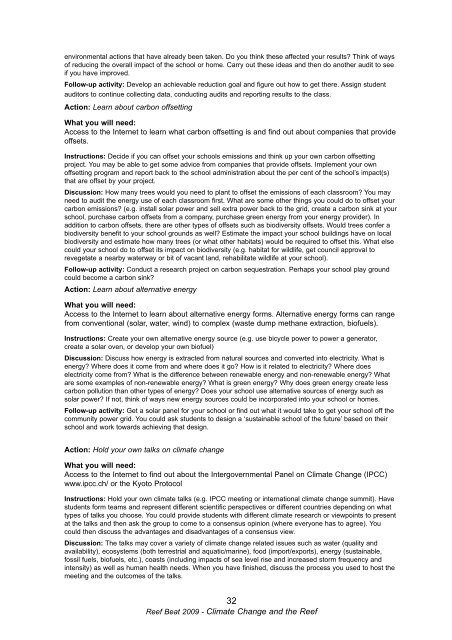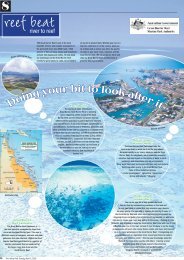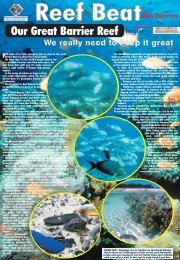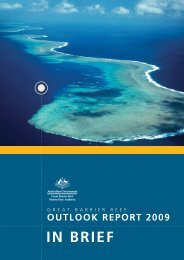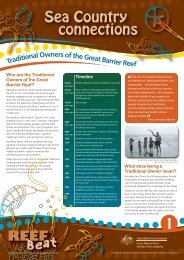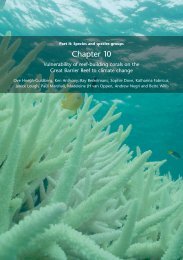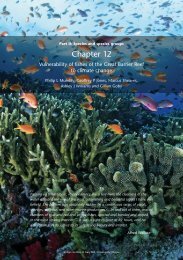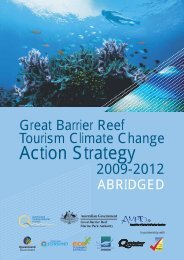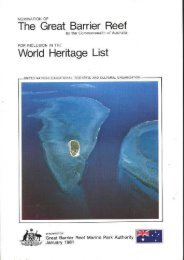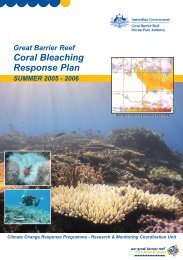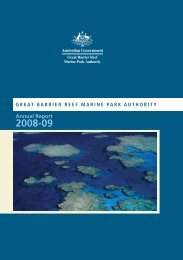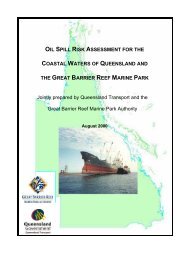ACTIVITIES BOOK - Great Barrier Reef Marine Park Authority
ACTIVITIES BOOK - Great Barrier Reef Marine Park Authority
ACTIVITIES BOOK - Great Barrier Reef Marine Park Authority
You also want an ePaper? Increase the reach of your titles
YUMPU automatically turns print PDFs into web optimized ePapers that Google loves.
environmental actions that have already been taken. Do you think these affected your results? Think of waysof reducing the overall impact of the school or home. Carry out these ideas and then do another audit to seeif you have improved.Follow-up activity: Develop an achievable reduction goal and figure out how to get there. Assign studentauditors to continue collecting data, conducting audits and reporting results to the class.Action: Learn about carbon offsettingWhat you will need:Access to the Internet to learn what carbon offsetting is and find out about companies that provideoffsets.Instructions: Decide if you can offset your schools emissions and think up your own carbon offsettingproject. You may be able to get some advice from companies that provide offsets. Implement your ownoffsetting program and report back to the school administration about the per cent of the school’s impact(s)that are offset by your project.Discussion: How many trees would you need to plant to offset the emissions of each classroom? You mayneed to audit the energy use of each classroom first. What are some other things you could do to offset yourcarbon emissions? (e.g. install solar power and sell extra power back to the grid, create a carbon sink at yourschool, purchase carbon offsets from a company, purchase green energy from your energy provider). Inaddition to carbon offsets, there are other types of offsets such as biodiversity offsets. Would trees confer abiodiversity benefit to your school grounds as well? Estimate the impact your school buildings have on localbiodiversity and estimate how many trees (or what other habitats) would be required to offset this. What elsecould your school do to offset its impact on biodiversity (e.g. habitat for wildlife, get council approval torevegetate a nearby waterway or bit of vacant land, rehabilitate wildlife at your school).Follow-up activity: Conduct a research project on carbon sequestration. Perhaps your school play groundcould become a carbon sink?Action: Learn about alternative energyWhat you will need:Access to the Internet to learn about alternative energy forms. Alternative energy forms can rangefrom conventional (solar, water, wind) to complex (waste dump methane extraction, biofuels).Instructions: Create your own alternative energy source (e.g. use bicycle power to power a generator,create a solar oven, or develop your own biofuel)Discussion: Discuss how energy is extracted from natural sources and converted into electricity. What isenergy? Where does it come from and where does it go? How is it related to electricity? Where doeselectricity come from? What is the difference between renewable energy and non-renewable energy? Whatare some examples of non-renewable energy? What is green energy? Why does green energy create lesscarbon pollution than other types of energy? Does your school use alternative sources of energy such assolar power? If not, think of ways new energy sources could be incorporated into your school or homes.Follow-up activity: Get a solar panel for your school or find out what it would take to get your school off thecommunity power grid. You could ask students to design a ‘sustainable school of the future’ based on theirschool and work towards achieving that design.Action: Hold your own talks on climate changeWhat you will need:Access to the Internet to find out about the Intergovernmental Panel on Climate Change (IPCC)www.ipcc.ch/ or the Kyoto ProtocolInstructions: Hold your own climate talks (e.g. IPCC meeting or international climate change summit). Havestudents form teams and represent different scientific perspectives or different countries depending on whattypes of talks you choose. You could provide students with different climate research or viewpoints to presentat the talks and then ask the group to come to a consensus opinion (where everyone has to agree). Youcould then discuss the advantages and disadvantages of a consensus view.Discussion: The talks may cover a variety of climate change related issues such as water (quality andavailability), ecosystems (both terrestrial and aquatic/marine), food (import/exports), energy (sustainable,fossil fuels, biofuels, etc.), coasts (including impacts of sea level rise and increased storm frequency andintensity) as well as human health needs. When you have finished, discuss the process you used to host themeeting and the outcomes of the talks.32<strong>Reef</strong> Beat 2009 - Climate Change and the <strong>Reef</strong>


